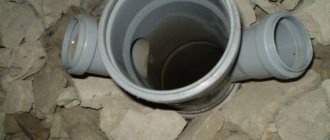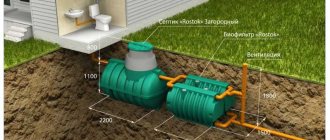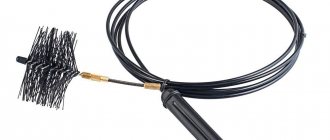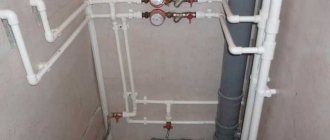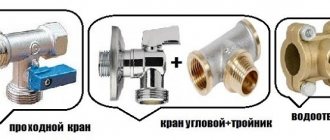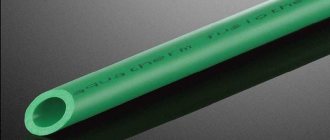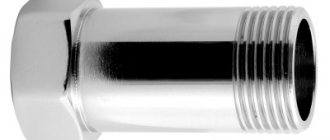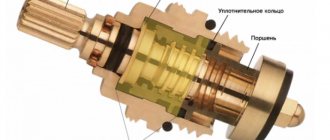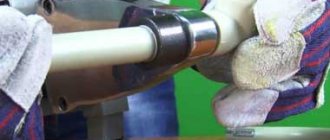An attractive and convenient way for most users is to repair a sewer pipe without dismantling it. Sometimes this method turns out to be the only method of system recovery.
Often dismantling is impossible due to expensive finishing, filling the pipes with concrete screed or placing the network in inconvenient conditions. If a hopeless blockage occurs in such an assembly, you will have to remove part of the pipe without sequentially dismantling the remaining elements. The connection principle of modern sewerage does not allow the work to be done in the usual way. You will have to use special methods, which need to be discussed separately.
General internal sewage system
The sewer system is a network of pipelines through which waste liquids are removed from premises and sent to treatment plants. There are internal and external sewerage systems. The first is located inside the building and performs the functions of collecting and removing waste from household appliances or plumbing. The second (outer) part ensures the movement of wastewater to treatment facilities. Most of the problems that occur with drainage systems occur in internal areas. This is due to the high likelihood of blockages and frequent mechanical stress. Before repairing a sewer pipe, it is necessary to study its design. Indoors, the pipeline consists of two sections:
- horizontal layout (lounger). These are plumbing outlet elements connected to a horizontal pipe; its diameter is usually 50 mm;
- riser. This is a vertical pipeline, the task of which is to drain wastewater to the external parts of the system, as well as ventilate the internal cavity of the pipelines.
The horizontal pipe is connected to a tee with a diameter of 110 mm. It is used to connect the toilet. Connection to the riser is made using another tee of the same size.
Modern pipes used to assemble drainage systems are made of plastic. Most often it is PVC. This is a cheap, fairly durable, lightweight material. Assembly and repair of plastic sewer pipes is not difficult and can be done with your own hands. The only problem when performing repair work may be dismantling the pipe line. The design of the plastic elements is such that to remove and replace a defective part, you have to disassemble the entire system from the starting point. This is inconvenient and makes work too difficult. In addition, if expensive repairs are made to the apartment, complete disassembly of the system becomes impossible. Repair of sewer pipes is required without dismantling other elements. This is a doable task, but it requires an understanding of the specifics of the system. Improper work can cause blockages.
Dismantling the old system and riser
Do-it-yourself replacement of a sewer riser occurs in stages in compliance with all safety rules. Before changing the sewer pipe, it is necessary to turn off the cold and hot water supply.
Next, all plumbing fixtures located near the work site are disconnected, which will prevent damage to them during the installation of the riser. To free access to old pipes that are planned to be replaced, it is often necessary to break the cement screed.
The most difficult and time-consuming step is the dismantling of the cast iron riser. A grinder makes cuts in the pipe at a distance of 60 cm from the tee up and 10 cm from the ceiling down. Each of them should occupy approximately half the diameter of the pipe. A chisel is installed at the cut points and several blows are made with a hammer. It is better not to replace the riser alone, because when it bursts, you will need help holding the pipe.
After removing the riser, carefully remove the tee, carefully rocking it and freeing it. At the last stage, the pipe socket is cleaned of dirt and the rest of the system is disassembled. Before installing a new cuff on the bell, you must carefully remove all traces of old grease. They can subsequently reduce the quality of the new sewer system. If plastic pipes are removed, they are removed section by section by rocking.
What are the problems with pipes?
Most systems are assembled from vinyl or propylene elements. They are inferior to cast iron parts in terms of strength. Before repairing a sewer system made of plastic pipes, you need to inspect the problem area and determine the type of fault. The most common defects are:
- blockage It is an accumulation of organic waste or particulate matter. Caught inside the pipeline. Blockages rarely appear immediately; they usually accumulate and increase in size gradually. The appearance of a blockage is indicated by a decrease in the rate of water outflow from the plumbing. If the blockage is not removed in time, it will develop into a traffic jam. It will completely block the pipe passage, which will stop the operation of the drainage system;
- crack. It usually appears due to mechanical loads applied to the pipeline. Plastic parts have some elasticity that compensates for destructive effects. However, under difficult operating conditions, plastic loses its properties and may crack. Most often this happens in cold weather, when PVC becomes brittle. This point must be taken into account when it is necessary to repair a sewer pipe in the ground in winter;
- loss of tightness of connections. To assemble the sewer system, socket elements with a rubber seal are used. They are reliable and easy to use. However, the condition of the rubber ring deteriorates over time. Leaks appear that require repair or replacement of the problem area of the system;
- fistula. This is a small hole through which sewage pours out. In plastic elements, a fistula may appear during repair or finishing work. It poses the greatest danger in underground areas. Earth gets into the hole, forming complex blockages.
Having established the type of defect, you can determine its cause and select methods and materials for sewer repair. The most critical elements are usually considered to be the sewer riser, especially in apartment buildings. Most often, you can only repair it in your own apartment. Neighbors rarely agree to dismantle the riser, since after this it will be necessary to restore repairs and finishing. In addition, dismantling is not possible on street lines, as this would be equivalent to laying a new system.
Also read: Installation of storm drainage on a highway: regulatory documents, elements, features
General recommendations for replacing sewer pipes
To ensure proper functioning of the water discharge system, all spigot points must be located in the direction of flow of water flow. This will provide easy access when connecting new sewer pipes to the riser.
Also, do not forget about safety precautions and use personal protective equipment. Review installation recommendations from manufacturers and professional locksmiths.
Failure to comply with the standards when replacing a sewer riser may lead to undesirable consequences that will lead to additional financial costs in the future. For example, particles of old cast iron entering the water supply system of a house.
It is more advisable to use plastic pipes
If you feel that you cannot do such work yourself, it is best to leave this task to the professionals. If you decide to do everything yourself, then be patient and follow our instructions.
Plastic pipes have proven themselves much better in operation, so all experts recommend using them exclusively. Thanks to their smooth surface, they will not allow impurities and bacteria to accumulate on their inner surface, as is the case with cast iron pipes. Therefore, you will not have to clean the pipeline often.
The materials for the manufacture of such pipes are polyvinyl chloride, polypropylene and low-density polyethylene. They are not only easy to install, but also easy to use.
Remedies
The most convenient and reliable way is to replace the problematic element. Repairing PVC sewer pipes requires a lot of time and the use of additional materials. However, if there are no other ways, you have to solve the issue using available means.
The first step is to determine the location of the leak. This is the main point on which the method of eliminating the problem depends. If there is a leak at the junction of parts, you will have to replace the damaged element. Destruction of the walls can be corrected without replacing the defective element. As a rule, if a plastic sewer pipe in an apartment is cracked, repairs are carried out using gentle methods. The element can be secured with a plaster, a clamp, or wrapped with electrical tape or tape. This option is only suitable for non-pressure systems. Channels that have undergone such repairs should not experience any mechanical stress.
If the crack is too large and its edges are bent inward, a replacement will have to be made. To do this, you will need a feed-through coupling and a spare part.
- the section of the damaged line is cut out with a grinder or a hacksaw with a fine tooth;
- the defective element is carefully removed from the socket;
- insert a new part;
- the entire coupling is put on the free end of the line;
- a piece of pipe is inserted into the socket so that the edges are connected;
- The coupling through passage is moved to the side so that the connection is inside it.
A more complex case is the repair of a sewer pipe in a screed. There is no way to accurately determine the type of damage; there is no access to the surface of the part. Problems usually arise due to thermal expansion of the plastic. The screed fixes the surface, and the material tends to change its dimensions. As a result, destructive stresses arise in it. In these cases, it is necessary to break the screed layer and replace the damaged sewer element. When refilling, it is necessary to provide a cavity for free movement of the part when heating or cooling. This will ensure its safety and durability.
Installation of a new riser
The assembly of the new system is carried out from the tee after installing the riser. An inspection window is installed in the riser on each floor.
First, a fitting is made with an allowance for the size of the bell. After the rough installation has been carried out, final assembly is carried out, joints are sealed and pipes are secured in clamps.
How to connect pipes
The joining of links is carried out in sockets using sealing material, which must be in each socket. To make the inserted element fit into the ring more easily and not damage it, the rubber is coated with oil, soap or Vaseline. The ends of the sawn pipes are ground down and polished. The riser branches and pipes with a diameter of 50 mm supplied to consumers are connected using special adapters. The toilet is connected to the drain through a corrugated pipe.
Sealing
Sealing of joints is carried out for preventive purposes, since rubber decreases in volume over time. If the pipes are planned to be covered with tiles or plastic after final installation, then it is advisable to take measures to additionally seal the joints.
For this we use:
- silicone lubricants;
- vulcanized rubber;
- adhesive tapes;
- mastic or bitumen;
- hemp or jute rope;
- technical sulfur.
Sealing agents must be applied to a dry, grease-free surface.
Checking for leaks
This event is carried out after the sealant has hardened, before closing the sewer pipes and shafts with finishing material.
The volume of liquid passed through must be sufficient to fill the pipe throughout its entire volume. The presence of a leak is detected by trickles or drops of water.
Internal wiring rules
Recommendations for sewer installation are as follows:
- create a slope of the drains towards the riser;
- purchase material from one manufacturer;
- do not save money by buying low-quality and defective pipes;
- Do not use excessive force when joining the links.
If possible, you should avoid right angles, choosing products with smooth transitions.
In what cases is it necessary to replace the riser?
Sewer lines must be replaced every 25-30 years
As a rule, apartment buildings are equipped with cast iron risers and water supply pipes. They are usually over 50-60 years old. During this time, the metal becomes unusable. Fistulas appear on the pipes and leaks are possible. Housing and communal services are required to change risers in the following situations:
- emergency condition of the collector;
- high loads on the wall due to metal weighed down by corrosion;
- pressure on plastic pipes installed below on the first floors or above a neighbor.
It is advisable to change the sewer riser on all floors at once. This way the communication will turn out to be solid from one material.
Who is responsible
Apartment owners, in order to prevent negative consequences, often reinstall risers and branches at their own expense. However, this is wrong.
According to Article 161 of the Housing Code and Russian Government Decree No. 354 of 05/06/11 (Article 149), the renovation and full installation of risers is entirely the responsibility of the housing management company. Every month the owner of the apartment pays bills, as well as for “maintenance and repair work.”
For this money, manipulations related to all communications must be carried out. In the event of an emergency, the housing company must update the pipes, and collecting money from people is considered illegal.
What documents are issued to the property owner?
Upon completion of the installation of the MKD water riser pipe, a “Certificate of Work Completed” must be drawn up, which will state the following:
- date of drawing up the contract;
- serial number of the agreement according to which the act is issued;
- the volume of work performed and all actions taken;
- cost of work;
- name of the person performing the repair work;
- signatures of the contractor and the customer.
Read more: Job description of the director of a construction LLC
This document is made in 2 copies, one of which is given to the contractor, and the second remains with the customer. The contractor is the organization that replaces the damaged element. The customer can be the management company (in which case one copy remains with them and is not given to the owner of the apartment) or directly the owner of the property.
Even if the agreement was drawn up by a representative of the management company and the repair company, the apartment owner should make himself a copy of this act.
